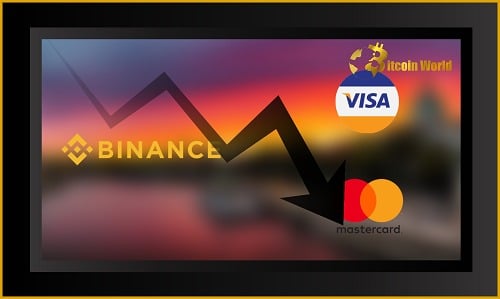The crypto world is witnessing significant shifts as major exchanges adapt to the evolving geopolitical landscape. Recently, Binance, a leading cryptocurrency exchange, took a decisive step by restricting the use of Visa and Mastercard cards issued in Russia. This move, triggered by international sanctions, has had a noticeable impact, causing a dip in crypto trading volumes involving the Russian ruble. While Russian citizens aren’t entirely cut off from the crypto sphere, these restrictions on traditional payment gateways are undeniably limiting their ability to engage in cryptocurrency trading.
Interestingly, this situation unfolds against a backdrop where many crypto exchanges have voiced opposition to broad bans targeting Russian users. However, the reality of sanctions against Russian financial institutions and businesses has forced many platforms to adjust their operations, leading to reduced access to cryptocurrency for some Russians. Adding to the complexity, concerns about asset security in the volatile crypto market are making some individuals hesitant to place their wealth in Bitcoin and other cryptocurrencies.
Visa, Mastercard, and American Express: A United Front Against Russian Operations
The decision by Binance is part of a larger trend. Financial giants Visa, Mastercard, and American Express have all suspended their operations in Russia. These companies cite US sanctions as the primary driver behind their decisions. Furthermore, a significant number of international banks have also ceased business activities within Russia, further isolating the country from the global financial system.
But how has this played out in the crypto markets? Let’s delve into the numbers.
Data from Kaiko, a reputable digital asset analytics provider, reveals a clear trend. Since Binance’s restrictive measures were implemented, trading volumes for Bitcoin and Tether denominated in rubles have steadily decreased. In fact, these volumes have now returned to levels seen before Russia’s invasion of Ukraine, suggesting a significant cooling off in crypto trading activity involving the Russian currency.
Ukraine vs. Russia: A Tale of Two Crypto Trading Trends
Kaiko’s analysis also highlights a stark contrast between crypto trading activity in Russia and Ukraine. Following the onset of the invasion, there was a surge in BTC-UAH (Bitcoin-Ukrainian Hryvnia) buying. This surge indicated that Ukrainian citizens were increasingly turning to cryptocurrencies as a safe haven amidst the financial turmoil and uncertainty in their nation.
Notably, trading volumes in Ukraine have remained elevated. Tether (USDT), a stablecoin pegged to the US dollar, has seen particularly strong demand. As the Ukrainian Hryvnia’s value plummeted, reports emerged of Ukrainians paying premiums as high as 20% to acquire this stable digital asset, underscoring its perceived value during economic instability.
Interestingly, the rise in BTC-RUB (Bitcoin-Russian Ruble) trading volumes didn’t immediately follow the invasion. It was only after the imposition of severe sanctions, particularly the exclusion of Russian banks from the SWIFT network, that BTC-RUB volumes began to climb. This suggests that the SWIFT ban and broader financial sanctions had a more direct and immediate impact on Russian crypto trading behavior than the initial invasion itself.
The Weight of Western Sanctions: Crippling Russia’s Financial Access
The sanctions imposed by Western nations on Moscow are unprecedented in their severity. These measures have effectively cut Russia off from major global financial markets, aiming to exert pressure on the Russian economy and government.
Adding to the economic pressure, the United States has recently banned Russian oil imports, and the European Union is actively considering similar measures. Given Russia’s heavy reliance on oil exports as a primary revenue source, such bans would further destabilize the Russian economy and potentially accelerate economic hardship.
Ruble’s Rocky Road: Recovering Slightly Against Bitcoin, Still Weak Against Major Currencies
Interestingly, the Russian ruble has shown some signs of recovery against Bitcoin. This recovery is largely attributed to the reduced BTC-RUB trading activity we discussed earlier. Currently, one Bitcoin is valued at approximately 4.6 million rubles, a decrease from the peak of over 5 million rubles observed last week. This doesn’t necessarily indicate a strengthening ruble in the broader sense, but rather a decrease in the ruble’s value when measured against Bitcoin in the specific context of reduced trading.
In traditional currency markets, the ruble remains under significant pressure. It continues to trade near record lows against both the US dollar and the Euro, reflecting the ongoing economic challenges and uncertainty facing the Russian economy.
Key Takeaways:
- Sanctions Bite: Restrictions on Visa and Mastercard in Russia, coupled with broader financial sanctions, are demonstrably impacting crypto trading volumes involving the Russian ruble.
- Ukrainian Crypto Surge: In contrast, Ukraine has witnessed a surge in crypto adoption and trading, particularly in stablecoins like Tether, as citizens seek refuge from financial instability.
- SWIFT Impact: The exclusion of Russian banks from SWIFT appears to be a key trigger for increased BTC-RUB trading initially, and subsequently for the decline following Binance’s restrictions.
- Ruble Volatility: While the ruble has shown some recovery against Bitcoin due to reduced trading, it remains weak against major global currencies, indicating persistent economic pressure.
- Evolving Crypto Landscape: The situation highlights how geopolitical events and financial sanctions can significantly shape the crypto market and influence user behavior.
The unfolding situation in Russia and Ukraine serves as a stark reminder of the interconnectedness of the global financial system and the growing role of cryptocurrencies in times of crisis and economic uncertainty. As sanctions and restrictions continue to evolve, the crypto market will likely remain dynamic and sensitive to these geopolitical forces.
Related Posts – Ferrari joins the NFT universe through a collaboration with a Swiss…
Disclaimer: The information provided is not trading advice, Bitcoinworld.co.in holds no liability for any investments made based on the information provided on this page. We strongly recommend independent research and/or consultation with a qualified professional before making any investment decisions.


